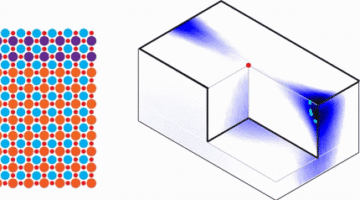Over 50 years ago, renowned physicists formulated theoretical models for the electronic structure of liquid metals. Now, for the first time, researchers observed the distinct spectral features predicted by those models, at the interface of a crystalline insulator (black phosphorus) and disordered dopants (alkali metals). Read more »
ALS Work Using ARPES
Angle-resolved photoemission spectroscopy (ARPES) is a technique in which a highly focused beam of x-rays is used to kick electrons out of the sample. By analyzing the ejected electrons' direction and energy, the researchers can obtain the material's band structure—a map of the electrons' behavior in the material.
Autonomous Data Acquisition for Scientific Discovery
Researchers at large scientific facilities such as the ALS have applied a robust machine-learning technique to automatically optimize data gathering for a variety of experimental techniques. The work promises to enable experiments with large, complex datasets to be run more quickly, efficiently, and with minimal human intervention. Read more »![]()
![]()
This Exotic Particle Had an Out-of-Body Experience; These Scientists Took a Picture of It
Scientists have taken the clearest picture yet of electronic particles that make up a mysterious magnetic state called a quantum spin liquid (QSL), in which electrons decompose into spin-like particles (spinons) and charge-like particles (chargons). The achievement could facilitate the development of superfast quantum computers and energy-efficient superconductors. Read more »
Tuning Semimetallicity Using Thin Films and Interfaces
With support from ALS data, scientists gained new insight into a semimetal’s unusual electronic behavior. The work lays out a basic strategy for engineering the band structures of semimetallic compounds using dimensional confinement and reveals a new way of creating two-dimensional electron/hole gases by exploiting interfacial bonding. Read more »![]()
![]()
Graphene Outperforms Metal Junctions for 2D Semiconductors
Researchers found that graphene performs ten times better than metal in transmitting a photoinduced current across interfaces with 2D semiconductors. Nanoscale-resolution band-structure measurements provided a deeper understanding of charge transport in these systems and will help in engineering more efficient contacts. Read more »
Actor in a Supporting Role: Substrate Effects on 2D Layers
ALS studies highlighted interactions that can occur between technologically intriguing 2D materials and the substrates that physically support them. The results provide important insights into the issue of non-negligible interlayer coupling and demonstrate the potential for tuning single-layer properties through substrate engineering. Read more »
The Flat Band in Magic-Angle Graphene Visualized
Researchers visualized flat band structures associated with exotic electronic phases in stacked graphene layers offset from each other by a “magic angle.” The work corroborates theoretical predictions and has significant implications for phenomena of technological and fundamental interest, such as topological phases and superconductivity. Read more »![]()
![]()
Scientists Dive Deep Into Hidden World of Quantum States
Researchers discovered two unique electronic properties—a Van Hove singularity and Fermi surface topology—at the interface between atomically thin oxide materials. The results suggest that the system is an ideal platform for investigating how to control superconductivity at the atomic scale in 2D materials. Read more »
A Scalable Platform for Two-Dimensional Metals
Using a new method for stabilizing a two-dimensional (2D) metal on a large-area platform, researchers probed the origins of the material’s superconductivity. The work represents a notable milestone in advancing 2D materials toward broad applications in topological computing, advanced optics, and molecular sensing. Read more »![]()
![]()
A Forked Path for Superconductivity
Uranium ditelluride (UTe2) exhibits a form of superconductivity that could, in theory, enable fault-tolerant quantum computing. Angle-resolved photoemission spectroscopy revealed several aspects of the material’s unusual electronic environment, including one-dimensional conducting channels that are orthogonally oriented. Read more »
- « Previous Page
- 1
- 2
- 3
- 4
- 5
- 6
- …
- 8
- Next Page »









